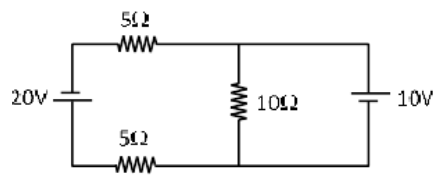A galvanic cell has electrical potential of 1.1 V . If an opposing potential of 1.1 V is applied to this cell, what will happen to the cell reaction and current flowing through the cell ?
The reaction stops and no current flows through the cell.
The reaction continuous but current flows in opposite direction.
The concentration of reactants becomes unity and current flows from cathode to anode.
The cell does not function as a galvanic cell and zinc is deposited on zinc plate.
The correct Answer is:A
To solve the problem regarding the galvanic cell with an electrical potential of 1.1 V and an opposing potential of 1.1 V, we can follow these steps:
1. Identify the Given Values:
- The electrical potential of the galvanic cell (E_cell) = 1.1 V
- The opposing potential applied (E_opposing) = 1.1 V
2. Calculate the Net Potential:
- To find the net potential acting on the cell, we subtract the opposing potential from the cell's potential:
Net Potential=Ecell−Eopposing=1.1V−1.1V=0V
3. Determine the Effect on the Cell Reaction:
- When the net potential is 0 V, it indicates that there is no driving force for the cell reaction to proceed. Therefore, the cell reaction will stop.
4. Analyze the Current Flow:
- Since the cell reaction has stopped, there will be no movement of electrons, which means that the current flowing through the cell will also be zero.
Conclusion:
- The cell reaction will stop, and no current will flow through the cell.
---
- The electrical potential of the galvanic cell (E_cell) = 1.1 V
- The opposing potential applied (E_opposing) = 1.1 V
- To find the net potential acting on the cell, we subtract the opposing potential from the cell's potential:
Net Potential=Ecell−Eopposing=1.1V−1.1V=0V
- When the net potential is 0 V, it indicates that there is no driving force for the cell reaction to proceed. Therefore, the cell reaction will stop.
- Since the cell reaction has stopped, there will be no movement of electrons, which means that the current flowing through the cell will also be zero.
- The cell reaction will stop, and no current will flow through the cell.
Topper's Solved these Questions
- ELECTROCHEMISTRYBook:NCERT FINGERTPS ENGLISHChapter:ELECTROCHEMISTRYExercise:HOTS
Explore 10 Videos
- ELECTROCHEMISTRYBook:NCERT FINGERTPS ENGLISHChapter:ELECTROCHEMISTRYExercise:EXEMPLAR PROBLEMS
Explore 17 Videos
- COORDINATION COMPOUNDS Book:NCERT FINGERTPS ENGLISHChapter:COORDINATION COMPOUNDS Exercise:Assertion And Reason
Explore 15 Videos
- GENERAL PRINCIPLES AND PROCESSES OF ISOLATION OF ELEMENTSBook:NCERT FINGERTPS ENGLISHChapter:GENERAL PRINCIPLES AND PROCESSES OF ISOLATION OF ELEMENTSExercise:Assertion And Reason
Explore 15 Videos
Similar Questions
Knowledge Check
In the circuit shown in figure the current flowing through 25 V cell is
 A7.2AB10AC12AD14.2A
A7.2AB10AC12AD14.2AIn the circuit shown in figure the current flowing through 25 V cell is
 A7.2AB10AC12AD14.2A
A7.2AB10AC12AD14.2A
Find current in 10V cell

View SolutionIf on applying the potential of 20V on a conductor its conductance becomes 8(Ω)−1, then the current flowing through it will be:
View SolutionThe cell reaction as written is spontaneous if the cell potential is:
View SolutionIn a galvanic cell, the half cell with higher potential provides a reducing agent.
View SolutionA plant cell is kept in a hypotonic solution. What will happen to the solute potential of this cell?
View SolutionUnlike dry cell, the mercury cell has a constant cell potential throughout its useful life, why?
View Solution


